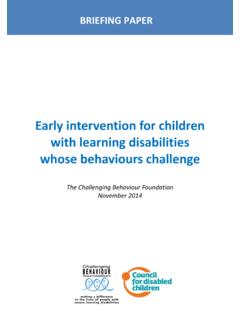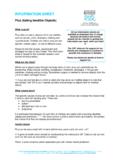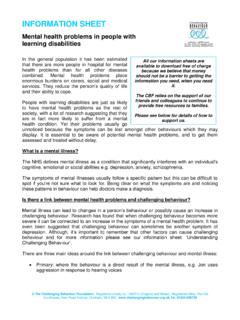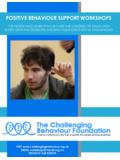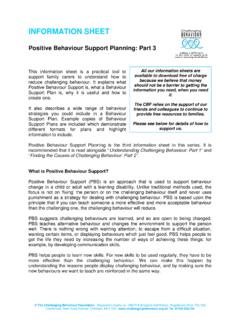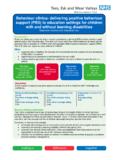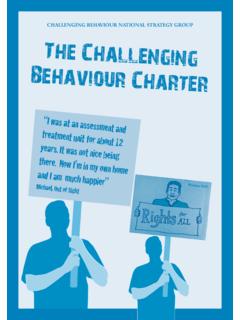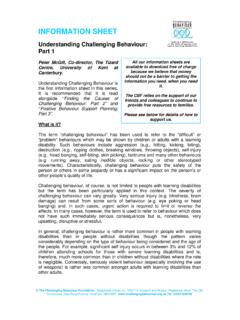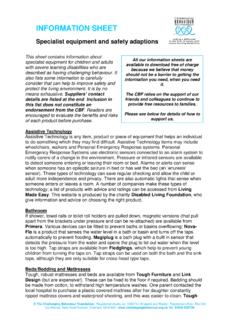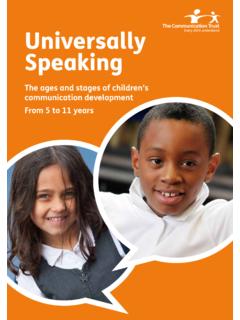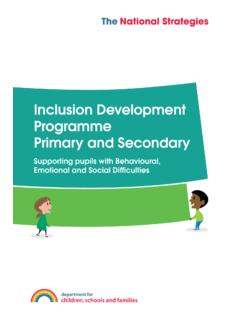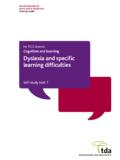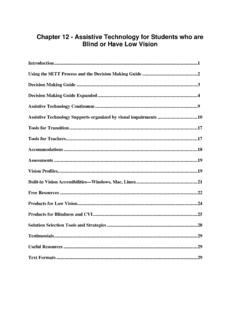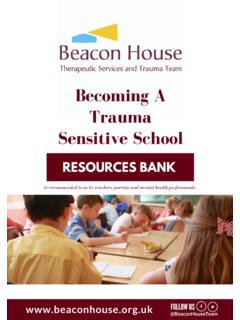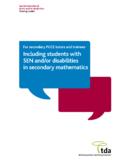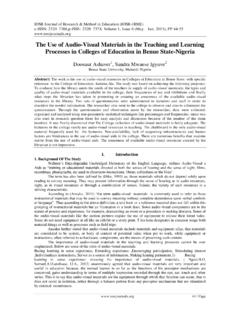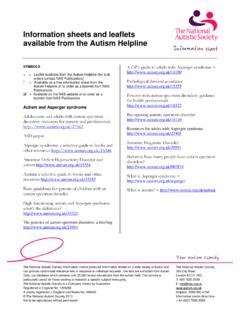Transcription of INFORMATION SHEET - The Challenging Behaviour …
1 1. INFORMATION SHEET . Communication and Challenging Behaviour Why is communication important? All our INFORMATION sheets are available to download free of charge Many people with learning disabilities find some because we believe that money parts of communicating hard. They might find it should not be a barrier to getting the hard to: INFORMATION you need, when you need Understand what other people say it. Tell other people what they want or how they feel The CBF relies on the support of our friends and colleagues to continue to If you can't tell other people what you want (or provide free resources to families. don't want!) Challenging Behaviour can be more likely. Making communication better can reduce Please see below for details of how to Challenging behaviours. support us. Common communication difficulties Knowing how much someone understands It can be difficult to know how much someone understands.
2 We get lots of clues from the context and what is happening around us. This is a good thing but sometimes it can make people think someone understands more words than they do. Using short sentences and giving people one bit of INFORMATION at a time can help. Some words are easier to understand than others Concrete concepts refer to things we can see and touch. These include people, places and objects ( mum, shops, table). Abstract concepts referring to things that cannot be seen or touched. These include negatives ( , not don't ), and time concepts ( , yesterday , this afternoon ). Abstract words are particularly difficult to understand. Sentences with abstract concepts in them can be easily misunderstood. Teacher's message - Sam, you're not going in the car . Message understood by Sam - I'm going out in the car . Sam does not understand "not" so thinks that he is going by car and becomes distressed when he realises he will have to walk.
3 The message would have been The Challenging Behaviour Foundation. Registered charity no. 1060714. Registered office: The Old Courthouse, New Road Avenue, Chatham, ME4 6BE. Tel. 01634 838739. 2. clearer to Sam if the teacher had told him what he was going to do , "Sam, we are going to walk . Longer and complex sentences are difficult Some people might understand one or two key words in a sentence. Some people might need simple sentences. Mother s message - "Hannah, you can have a drink after you've tidied your room . Message understood by Hannah - I'm having a drink and then tidying my room". In English, what we say first is usually what we want the person to do first. Hannah becomes upset when she is expected to tidy her room and has not yet had her drink. Taking things literally If someone has done something that we find irritating we might say "Oh, that's great!
4 ", when we actually mean the opposite. People might take things literally and so misunderstand. In English we use lots of phrases that must sound very strange if you take it literally, I laughed my head off . Hearing loss Lots of people with learning disabilities have a hearing loss. This can make communication even more difficult. Difficulties in sending messages People with learning disabilities might have lots of difficulty communicating their needs and wishes. This might include: Not being able to speak or only having a few words, signs or gestures Having speech, signs or gestures that are very unclear Struggling with the social rules making eye contact, knowing when to speak and how much to say Not being able to say no'. Not being able to say I don't understand'. Not being able to express feelings For example, John is asked to go shopping.
5 He is unable to tell people that he isn't in the mood to do this as he has had a busy morning. He would probably be happy to go after he has had a rest. He is unable to communicate these things and becomes upset and starts to scream when he is given his coat. Other ways of communicating The Challenging Behaviour Foundation. Registered charity no. 1060714. Registered office: The Old Courthouse, New Road Avenue, Chatham, ME4 6BE. Tel. 01634 838739. 3. Finding additional or alternative ways to communicate can be really helpful. This is called Alternative and augmentative communication (AAC). This means using different types of communication including: Objects of reference: These are objects that have particular meanings associated with them. For example, using a cup to let the person know that it is time for a drink. Signed communication: This is where shapes (signs) made by people's hands represent words in the same way that sounds coming out of people's mouths represent words.
6 Symbols or photos: Symbols ( line drawings) and photographs can also be used to represent words. For example, an outline of a house can be used to represent home'. Voice Output Communication Aids (VOCA): These speak' messages when pressed. There are lots of different types of VOCAs. Some devices are for recording one message ( drink) on a switch' or large button. Others are capable of producing many different sentences, on a special computer or an app. Total communication approaches: (where all means of communication are supported) are useful. Families sometimes worry that giving someone another way to communicate might mean they won't learn to talk but the research shows that giving people other ways of communicating can help people to talk. How to support communication Make sure you gain the person's attention before you communicate Use short and simple sentences Give people plenty of time to process what you have said Use additional communication where you can.
7 This might be using symbols, signs, photographs or gestures ( pointing to someone's shoes when asking them to put them on). Give people lots of opportunities to communicate and give them lots of time to respond Make sure everyone knows how to communicate with the person (using a communication passport). Try to respond consistently to any attempts to communicate Intensive Interaction Some children, young people and adults with a severe learning disability may find communication and being social very difficult. An approach called Intensive Interaction is a practical way of supporting someone to interact with others. It is a person-centred approach where encouragement to engage in social interactions is done at the pace of the individual and on their terms'. Many family carers use this kind of interaction naturally with their family member, to connect and enjoy their company.
8 The Challenging Behaviour Foundation. Registered charity no. 1060714. Registered office: The Old Courthouse, New Road Avenue, Chatham, ME4 6BE. Tel. 01634 838739. 4. Where to go next To access speech and language therapy, you can ask your GP, district nurse, health visitor, your child's nursery staff or teacher for a referral. You may also be able to refer yourself to your local speech and language therapy service, see: Speech and language therapy is more commonly available to children than adults, but there is no age limit and adults with learning disabilities can continue to learn new ways to communicate. Useful organisations Afasic: A UK charity that aims to help children and young people affected by speech, language and communication impairments, their families and the professionals working with them. Their website also features lots of INFORMATION sheets about speech and language impairments.
9 For more INFORMATION visit: , tel: 0300 666 9410 or contact via website. Communication Matters: A UK charity that supports people who find communication difficult because they have little or no clear speech. For more INFORMATION visit: , tel: 0845 456 8211 or email: Find a Voice: A UK based charity that provide advice and support to people with speech and communication difficulties, including INFORMATION on obtaining funding. For more INFORMATION visit: , tel: 01233 634625 or contact via website. 1 Voice: A network and support for children and families caring for someone with communication needs. For more INFORMATION visit: , tel: 07943 618525 or email: Talking Point: A charity that provide advice and INFORMATION for parents and carers of children with speech and language difficulties. For more INFORMATION visit: , tel: 020 7843 2544 or email: Objects of Reference CALL Scotland have produced a useful leaflet about introducing objects of reference The Challenging Behaviour Foundation.
10 Registered charity no. 1060714. Registered office: The Old Courthouse, New Road Avenue, Chatham, ME4 6BE. Tel. 01634 838739. 5. Signing Makaton: Makaton is a language programme that uses signs and symbols to help people communicate. The Makaton charity aims to provide training, resources, advice and support to families and professionals. For more INFORMATION visit: , tel: 01276 606778 or email: Signalong: The Signalong Group is a registered charity that is dedicated to helping people with speech and language problems overcome difficulties by teaching a sign support system. For more INFORMATION visit: , tel: 01634. 727087 or email: Symbols Picture Exchange Communication System (PECS): PECS is an approach that uses pictures to develop communication skills. The following website provides basic INFORMATION about PECS and gives details of PECS training workshops.
